Whirling disease is a parasitic infection of fish caused by a microscopic protozoan Myxobolus cerebralis which is a group representative of the Myxosporean parasite.
Whirling disease is a concerning affliction that affects fish, particularly salmonids like trout and salmon. Understanding the causes, recognizing the symptoms, and exploring available treatment options are crucial steps in managing and mitigating the impact of this disease on fish populations.
In this comprehensive post, we delve into the intricate details of whirling disease. We examine the life cycle of the parasite, uncover the factors contributing to its spread, and shed light on the symptoms exhibited by infected fish. Furthermore, we explore the treatment strategies employed to combat this debilitating disease.
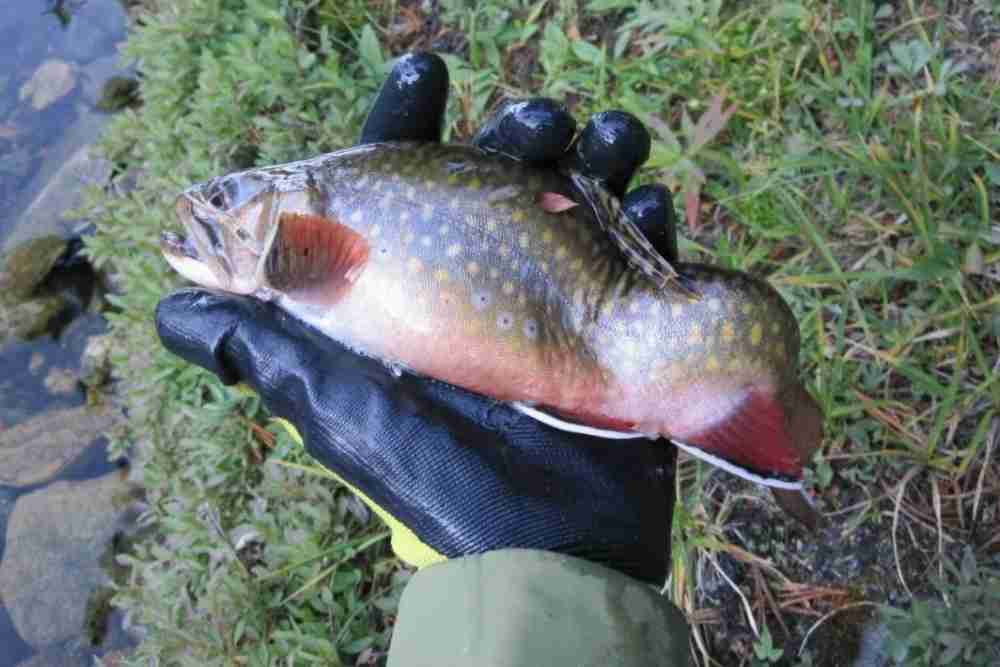
What Causes Whirling Disease in Fish?
Whirling disease is caused by a microscopic parasite called Myxobolus cerebralis. This parasite primarily affects salmonid fish, such as trout and salmon.
The disease is primarily transmitted through direct contact between infected and susceptible fish or through contaminated water sources.
Morphology of Myxobolus cerebralis

Myxosporeans are a group of parasitic protozoans that belong to the phylum Myxozoa. Myxozoa is a species group of endoparasitic cnidarians that can cause severe ecological and economic effects.
They are commonly found in aquatic environments, especially in the marine ecosystem. They are mostly pathogenic to both wild and farmed fish.
Life Cycle of Myxobolus cerebralis
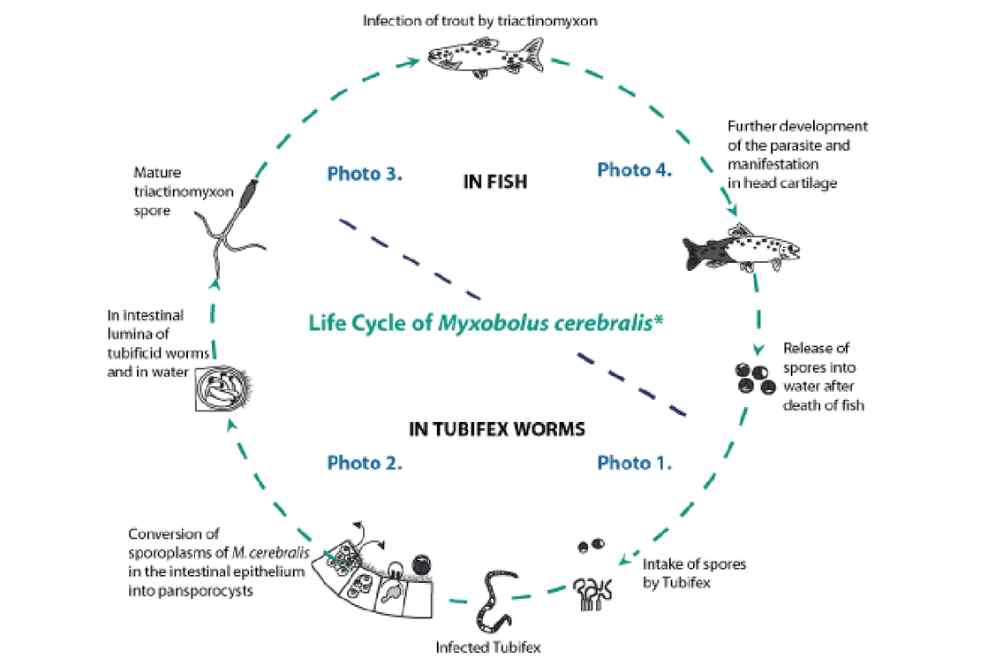
The life cycle of the parasite involves two hosts: a tubificid worm (an aquatic oligochaete) and a salmonid fish.
The parasite begins its life cycle as spores released by infected fish. The life cycle of whirling disease begins with microscopic spores present on the river bottom.
These spores are consumed by bottom-dwelling tubifex worms. Within the tubifex worms, the spores undergo a transformation and become Triactinomyxons (TAMs). This stage is capable of infecting fish.
When the infected tubificid worm is consumed by a susceptible salmonid fish, the triactinomyxon is released and enters the fish’s body. The parasite then invades the fish’s cartilage, particularly affecting the cranial and spinal cartilage.
When the infected fish dies and decomposes or is consumed by a predator, the spores within its body are released into the water, initiating the cycle a new.
The life cycle of Myxobolus cerebralis, a parasitic organism, involves several stages:
Stage 1: M. cerebralis is ingested by T. tubifex. The myxospore develops within the oligochaete host Tubifex tubifex.
Stage 2: The polar filaments are extruded, and the M. cerebralis spore anchors itself into the gut epithelium. The shell valves open, allowing the binucleate sporoplasm to escape and penetrate between epithelial cells.
Stage 3: The binucleate sporoplasm undergoes inter-epithelial schizogonic multiplication.
Stage 4: The sporoplasm transforms into uninucleate 1-cell stages.
Stage 5: Two uninucleate cells fuse through plasmogamy, resulting in the formation of a binucleate cell-stage.
Stage 6: Both nuclei within the binucleate cell undergo mitotic division, giving rise to a 4-nuclei stage.
Stage 7: Plasmotomy occurs, forming a 4-cell stage where two cells begin to envelop the other two cells.
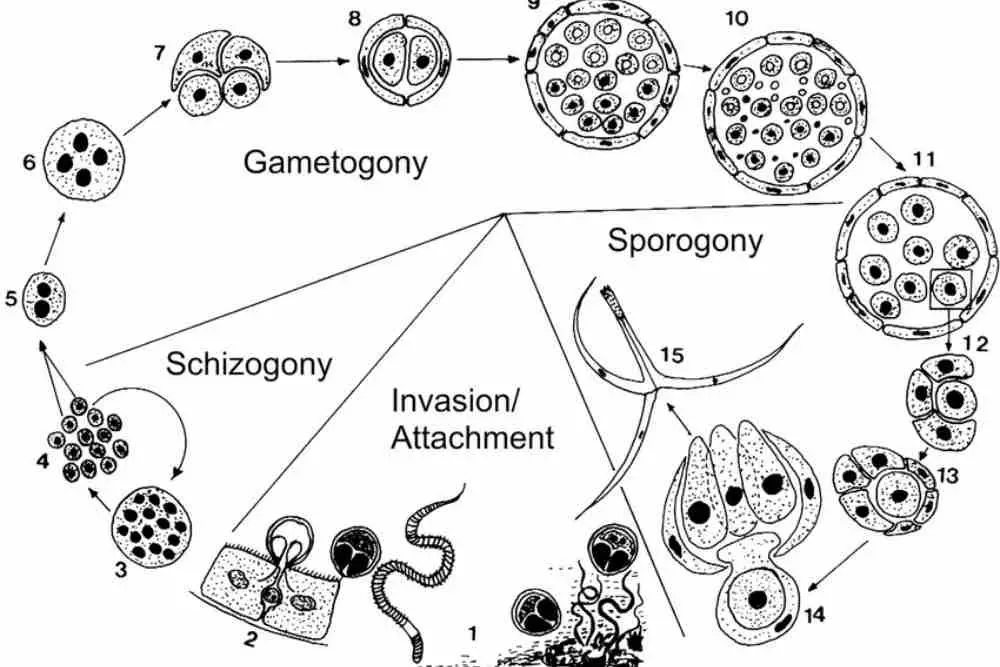
Stage 8: An early pansporocyst is formed, consisting of two somatic cells and two generative cells.
Stage 9: Through three mitotic divisions of both generative cells and two mitotic divisions of the somatic cells, 16 gametocytes (8α and 8β) enveloped by eight somatic cells are produced.
Stage 10: Meiotic division of the 16 diploid gametocytes leads to the formation of 16 haploid gametocytes and 16 polar bodies.
Stage 11: Copulation of each pair of α- and β-gametes results in the production of eight zygotes.
Stage 12: After two mitotic divisions of the zygote, three pyramidally arranged cells and one inner cell form, leading to sporoblast formation.
Stage 13: The three peripheral cells undergo mitotic division, producing three capsulogenic and three valvogenic cells.
Stage 14: The valvogenic cells extend around the capsulogenic cells, while internal cleavage of the developing sporoplasm cell produces one generative cell enveloped by one somatic cell. The sporoplasm remains naked in the pansporocyst until reaching the final number of germs through repeating mitotic divisions.
Stage 15: The mature triactinomyxon spore inflates, completing the life cycle of Myxobolus cerebralis.
Geographical Distribution & Affected Species of Whirling Disease
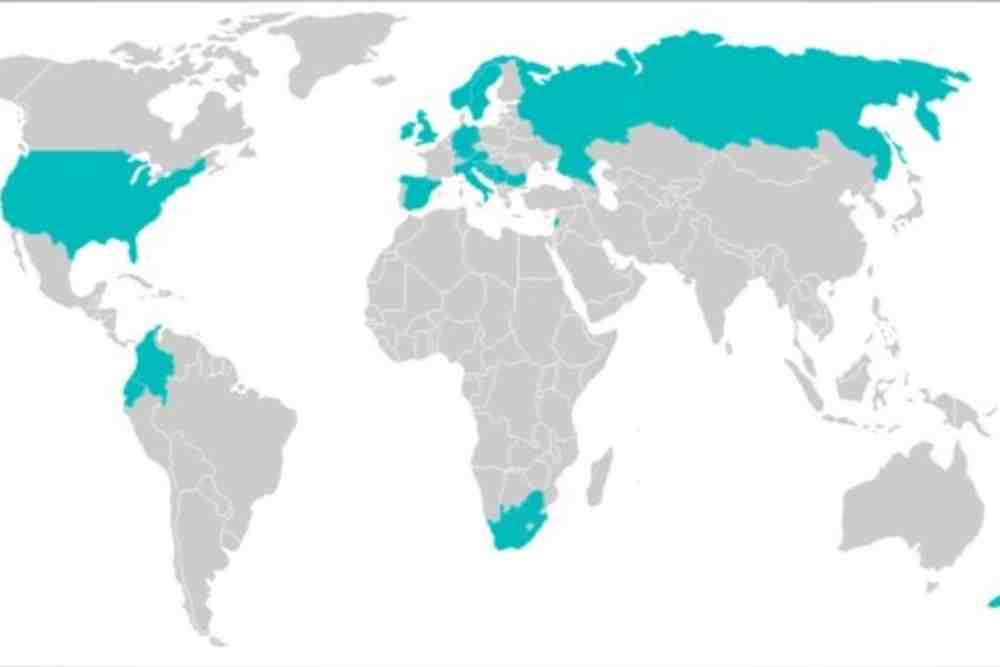
The first confirmed outbreak of whirling disease occurred in Germany in rainbow trout. It is native to the Eurasian continent.It had been detected from France, Germany and Denmark from 1903 until 1952.
Several European countries,in south Africa,and in New Zealand whirling disease is found.In the United States it has been found and Monata , Colorado be the most heavily affected.
The disease affects young trout, causing skeletal deformities and high mortality rates. The parasite responsible for the disease is Myxobolus cerebralis.
The parasite was first detected in U.S. waters in the 1950s and was found in northeastern Oregon in 1986. It was also discovered in a trout hatchery on a tributary of the Clackamas River in 2001.
A surveys conducted by the Oregon Department of Fish and Wildlife (ODFW) since 1997 have identified the parasite in adult steelhead, spring chinook, and sockeye that have strayed into the Deschutes River below the Pelton-Round Butte hydroelectric dams.
A report from scientists at Oregon State University’s Center for Fish Disease Research confirms that the disease has become permanently established in the lower Deschutes River Basin.
The parasite has been found in multiple locations near Trout, Buck Hollow, and Mud Springs creeks, as well as near Oak Springs Hatchery near Maupin.
Causing Signs and Symptoms by Myxobolus cerebralis
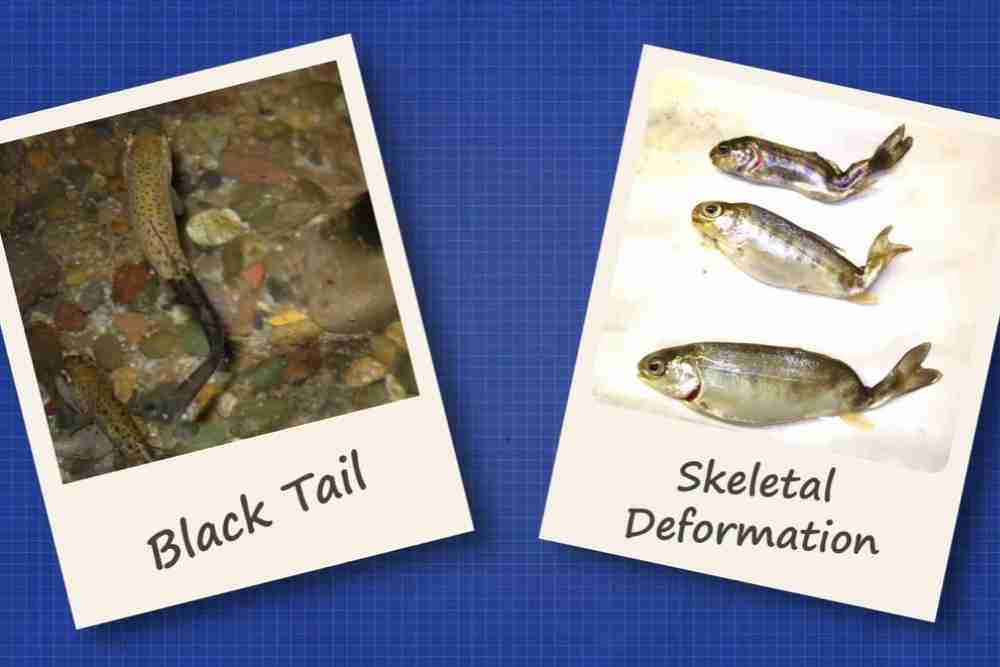
-The TAM attaches to the fish’s skin and injects its own cells, which travel along the fish’s nervous system to reach the cartilage and gradually consuming its cartilage and skeletal tissue. The cells feed on the cartilage and develop into the spore stage, leading to degradation of the fish’s skeleton and inflammation.
–This insidious invasion can result in various distressing symptoms such as the development of a black tail, deformities in the head and spine, or the manifestation of erratic and disorienting tail-chasing behavior, hence the name “whirling” disease.
–Impaired swimming abilities, compromised feeding habits, and reduced ability to evade predators are among the consequences suffered by afflicted fish.
Ultimately, when the infected trout meets its fate, the parasite is released back into the environment, marking the beginning of a new cycle, ready to perpetuate the damaging effects of whirling disease once again.
Diagnosis of Myxobolus cerebralis
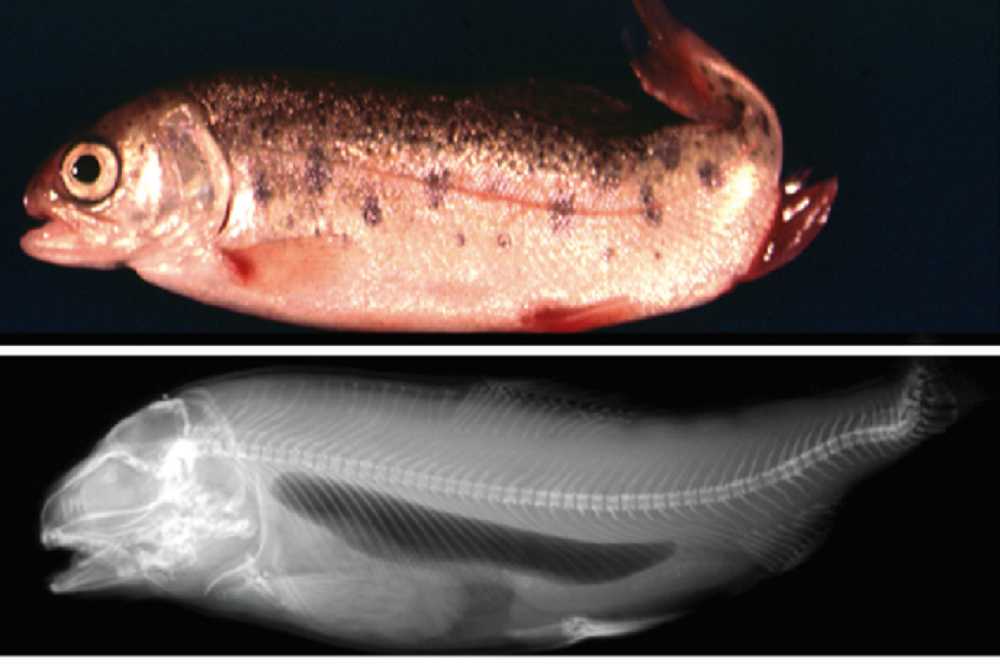
Morphometric Identification: Morphometric diagnosis of Myxosporean disease in fish involves the use of microscopic examination, x-ray, histopathology and morphometric analysis of the Myxosporean parasite to identify and classify the species of the parasite causing the disease.
Molecular identification of Myxosporean: Myxosporean parasites in fish involve the use of molecular biology techniques to identify and classify the parasite at the DNA level.
How Do You Prevent the Spread of Whirling Disease
To prevent the spread of parasites and ensure responsible fishing practices, it is important to follow these guidelines:
-To prevent the spread of whirling disease, it is essential to clean waders, boats, paddles, and any equipment that comes into contact with water, ensuring they are free of mud or plant matter. Clean all equipment, including boats, trailers, waders, float tubes, and mud-caked fins, before leaving a fishing area.
-Water should be drained from boats onto dry land, and all watercraft and equipment should be thoroughly dried for 24 hours. Boat inspection stations can help ensure equipment is clean.
-Additionally, the clean-drain-dry methodology is crucial for preventing other aquatic invasive species like Eurasian milfoil and zebra and quagga mussels.
-Do not transport live fish from one water body to another.
-Avoid disposing of fish heads, skeletons, or entrails in any body of water.
-Recreational and sports fishers play a vital role in preventing the spread of parasites, so please adhere to best practices.
-Comply with federal, state, provincial, and local regulations regarding the use of bait.
Whirling Disease Treatment
Treatment for whirling disease can involve a combination of different products to effectively combat the infection. In-tank treatment can be performed using either pharmaceutical-grade AAP Furacyn or lower-grade Furan 2, along with AAP Super Ich Plus or ParaGuard. This combination helps to target the disease-causing parasite within the aquarium or pond.
For a fish bath, Methylene Blue and sodium chloride are recommended along with Super Ich Plus or ParaGuard. This fish bath solution aids in treating the affected fish outside of their main habitat.
To address whirling disease through fish food, a soak with Metronidazole and praziquantel is recommended. This method helps deliver the medication directly to the fish’s system, providing an effective treatment approach.
It is important to source the recommended products from reliable suppliers that support the aquarium and pond keeping hobby. These sources include AAP Metronidazole, AAP ParaGuard, AAP Super Ich Plus, AAP Yellow Powder (Premium Nitrofurazone Blend), AAP Nitrofurazone/Furan 2, and AAP General Cure (which contains both Praziquantel and Metronidazole).
Additionally, Naladixic Acid can be an excellent product for addressing symptoms that mimic whirling disease in aquariums, particularly in cases where true whirling disease is not present. Combining Naladixic Acid with products like Metronidazole or Medicated Wonder Shells, especially for Discus and other Cichlids, has proven to be effective. AAP offers Naladixic Acid in the form of the product “Naladin.”
For prevention purposes in unaffected fish, AAP/SeaChem Cupramine can be used, although its effectiveness as a treatment is limited. Similarly, the Medicated Wonder Shell, which contains a form of copper similar to Cupramine, can be beneficial and also improves mineral cations and electrolytes in the aquarium.
It is recommended to obtain these products from reliable sources that support the aquarium and pond keeping hobby, such as AAP Medicated Wonder Shells and AAP Cupramine. By following these treatment approaches and using high-quality products, it is possible to combat whirling disease effectively and support the well-being of aquarium and pond fish.
Whirling Disease in Aquarium Fish Species
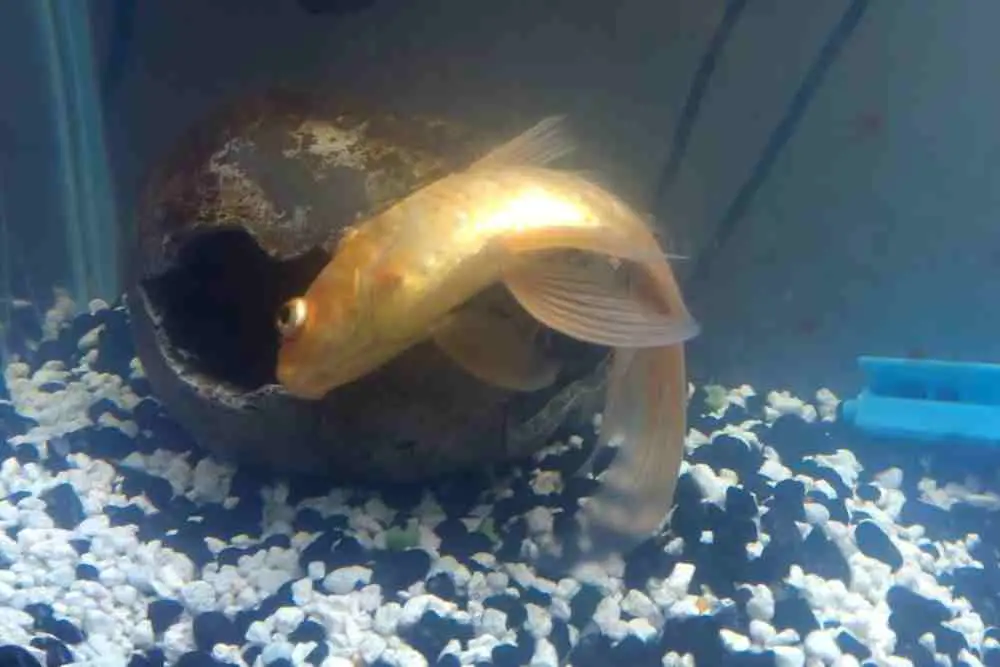
Several aquarium species can be affected by Myxobolus cerebralis, the parasite responsible for causing whirling disease. The disease primarily affects salmonid fish, including trout and whitefish, which are commonly kept in aquariums.
Reference
- Hedrick, R. P., & El-Matbouli, M. A. N. S. O. U. R. (2002). Recent advances with taxonomy, life cycle, and development of Myxobolus cerebralis in the fish and oligochaete hosts. In American Fisheries Society Symposium (pp. 45-54). American Fisheries Society.
- Sarker, S., Kallert, D. M., Hedrick, R. P., & El-Matbouli, M. (2015). Whirling disease revisited: pathogenesis, parasite biology and disease intervention. Diseases of aquatic organisms, 114(2), 155-175.
- Stevens, R., Kerans, B. L., Lemmon, J. C., & Rasmussen, C. (2001). The effects of Myxobolus cerebralis myxospore dose on triactinomyxon production and biology of Tubifex tubifex from two geographic regions. Journal of Parasitology, 87(2), 315-321.
- Molnar, K. (1994). Comments on the host, organ and tissue specificity of fish myxosporeans and the types of their intrapiscine development. Parasitol Hung, 27, 5-20.
- MacKenzie, K., & Kalavati, C. (2014). Myxosporean parasites of marine fishes: their distribution in the world’s oceans. Parasitology, 141(13), 1709–1717. https://doi.org/10.1017/S0031182014001425
- Molnar, K., Eszterbauer, E., Székely, C., Dán, Á., & Harrach, B. (2002). Morphological and molecular biological studies on intramuscular Myxobolus spp. of cyprinid fish. Journal of Fish Diseases, 25(11), 643-652.
- Feist, S. W., & Longshaw, M. (2006). Phylum Myxozoa. In Fish diseases and disorders. Volume 1: protozoan and metazoan infections (pp. 230-296). Wallingford UK: CABI.
- Reid, A. J., Carlson, A. K., Creed, I. F., Eliason, E. J., Gell, P. A., Johnson, P. T., & Cooke, S. J. (2019). Emerging threats and persistent conservation challenges for freshwater biodiversity. Biological Reviews, 94(3), 849-873.
- Gilbert, M. A., & Granath Jr, W. O. (2003). Whirling disease of salmonid fish: life cycle, biology, and disease. Journal of Parasitology, 89(4), 658-667.
- Hoffman, G. L. (1990). Myxobolus cerebralis, a Worldwide Cause of Salmonid Whirling Disease.
- EL-MATBOULI, M. (1999). Whirling disease: host specificity and interaction between the actinosporean stage of Myxobolus cerebralis and rainbow trout Oncorhynchus mykiss. Dis. Aquat. Org., 35, 1-12.
- El-Matbouli, M., Hoffmann, R. W., Schoel, H., McDowell, T. S., & Hedrick, R. P. (1999). Whirling disease: host specificity and interaction between the actinosporean stage of Myxobolus cerebralis and rainbow trout Oncorhynchus mykiss. Diseases of Aquatic Organir, E. J. (2002).
- Wagner, E. J. (2002). Whirling disease prevention, control, and management: a review. In American Fisheries Society Symposium (pp. 217-226). American Fisheries Society.
